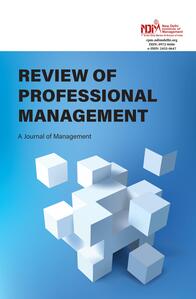
1Department of Commerce, Bishop Heber College (Autonomous), Bharathidasan University, Tiruchirappalli, Tamil Nadu, India
Creative Commons Non Commercial CC BY-NC: This article is distributed under the terms of the Creative Commons Attribution-NonCommercial 4.0 License (http://www.creativecommons.org/licenses/by-nc/4.0/) which permits non-Commercial use, reproduction and distribution of the work without further permission provided the original work is attributed.
Purpose: The present study aims to examine the financial performance before and during the COVID-19 pandemic with respect to profitability ratios, liquidity ratios, solvency ratios and economic value added (EVA) of select Indian public sector banks listed in the Bombay Stock Exchange (BSE).
Design/Methodology/Approach: In total, 12 public sector banks listed on the BSE were chosen for the analysis, which spans the years 2018–2019 to 2019–2020. Financial statements and monthly closing prices of public sector banks are the data that were gathered for this study. The tools used in this study are as follows: (1) EVA, (2) financial ratios, (3) descriptive statistics, (4) Shapiro–Wilk normality test and (5) paired samples t-test. Findings of the study are as follows: The empirical findings of the study revealed that the COVID-19 pandemic has a negative effect on earnings per share, net profit ratio, return on capital employed, return on asset and return on equity and a positive effect on current ratio, debt to equity ratio and EVA of select public sector banks.
Research Limitations/Implications: The findings of this study provide several avenues for more research. As one of the research ramifications, future researchers would need to explain discrepancies in the statistical findings of various academics in the finance field.
Social Implications: As the expansion of the banking industry is correlated with India’s economic growth, developing nations like India rely on the accuracy of the information. With the information provided, the COVID-19 pandemic has a negative effect on profitability variables and positive effect on liquidity, solvency and shareholder’s wealth creation variables, so that it has no serious harmful consequences on the economy in respect to profitability position of select banks.
Originality/Value: The study is conducted on the financial performance before and during the COVID-19 pandemic with respect to profitability ratios, liquidity ratios, solvency ratios and EVA of select Indian public sector banks listed in BSE and also highlighted how banks adapted the pandemic situation, which is a new phenomenon.
Economic value added, shareholders wealth, financial ratios, COVID-19 pandemic and paired samples t-test
Introduction
Coronavirus first appeared in India in January 2020, infecting millions of people worldwide and resulting in thousands of deaths. In order to combat COVID-19, the Indian government imposed a nationwide lockdown on 24 March 2020, which was later extended till 3 May 2020. Many countries throughout the world have taken similar moves as India. However, the government of India’s efforts to stop the spread of the COVID-19 epidemic had an adverse impact on the gross domestic product of the nation. ‘One of the most significant segments of the Indian economy is the banking sector, which oversees all financial activities in the nation and acts as a support system for all businesses, including financing, credit, transactions, collection, and payment’ (Weber & Darbellay, 2010). The performance of the Indian banking industry in terms of non-performing assets, profitability, advances, and other metrics has been significantly impacted by COVID-19. Indian banks encountered difficulties during the pandemic, which had a negative effect on their earnings. They have overcome various challenges, and the changes they have made have had an impact on their financial standing. Major reasons included an increase in non-performing assets, non-repayment of loans, profitability, and the creation of shareholder wealth. As a result, bank profitability is likely to fall beginning in 2019. The Reserve Bank of India and the Indian government analysed financial performance and the impact of COVID-19 on the banking sector through various policy actions at the national and state levels. Some economists anticipate that the financial sector would take a long time to recover from the effects of the COVID-19 outbreak, particularly in India.
The Indian government has implemented a number of steps to reduce the consequences of the coronavirus outbreak, including a statewide lockdown, a request for residents to remain indoors, the closing of public areas, transportation, social distancing and working from home (Nicola, 2020). The resulting economic dispersion is substantial, with a temporary reduction in business activity (Perwej, 2020). Governments took mitigation measures to facilitate the development of the innovative COVID-19 (Demirgüç-Kunt et al., 2020). This type of issue has also impacted India’s banking industry. Even the World Health Organization (WHO) has advised people to use contactless payment options instead of touching bank notes as much as possible. Banking notes have been used to spread the Coronavirus (Bobade & Alex, 2020).
The pandemic moved the Indian banking system from stable to negative, causing the majority of economic operations to be hampered (Bobade & Alex, 2020). Lockdowns and lowered output have already begun to have an impact on the corporate sector’s finances due to corporations’ inability to repay their loans. Many people lost their jobs as a result of the pandemic, and they skipped loan payments, which impacted bank efficiency and profitability and raised Non-Performing Assets. As a result, the moratorium, which was declared on 27 March 2020, is one of the RBI’s initiatives. All lending institutions have been granted permission by the RBI to stop making instalment payments on all outstanding term loans as of 1 March 2020, for a three-month (later extended to six-month) period. This shows that COVID-19 has had a substantial impact on the banking industry’s income statement and financial stability, which has changed a number of variables including profitability ratios, liquidity ratios, solvency and the accumulation of shareholder wealth. Therefore, it is essential to examine the financial performance before and during the COVID-19 period of 12 public sector banks listed in BSE in India.
Literature Review
Dynamically, we find that volatility connection increased during crises, peaking at the time of Covid-19. The study emphasises the importance of large banks in volatility transmission, emphasising the banking system’s “too-big-to-fail” trait. Small-medium banks, on the other hand, are key contagion actors, reinforcing the theory that the Eurozone banking system is too interconnected to fail. Finally, we show how the COVID-19 epidemic has created heterogeneity among Eurozone banking institutions. This heterogeneity impact could be a future source of financial instability within the Eurozone. (Foglia et al., 2022)
‘The banking system remains a critical component of economic stability, and research on the financial system’s impact on the economy during extreme occurrences such as a pandemic is an unavoidable requirement of the moment’ writes Trivedi (2021). Kumar and Kumar (2021) carried out,
a research study titled Impact of Covid-19 on Indian Economy with Special Reference to Banking Sector: An Indian Perspective, demonstrates overview of the impact of Covid-19 situation on Indian economy and its banking sector and also analyses the various policy measures taken by Reserve Bank of India and Indian Government at centre level and state level to improve the current economic situation of the country.
Singh and Bodla (2020) carried out,
a research study titled COVID-19 Pandemic and Lockdown Impact on India’s Banking Sector: A Systemic Review of the Literature, illustrates the impact of the pandemic on banks and Non-Banking Financial Companies as an outcome of the lockdown, which has resulted in the closure of all commercial organisations, educational institutions, public and private offices, suspension of means of transportation, and so on, by taking into account the perspectives of economists, financial institutions such as the IMF and the World Bank, as well as consulting firms.
Fraser et al. (2016) offer,
four types of ratios used to assess a company’s financial performance. They are the liquidity ratio, which describes the company’s ability to meet short-term liabilities (debt), the solvency ratio (leverage), which measures the degree to which the company’s assets are financed by debt, the activity ratio, which assesses the company’s ability to generate income, and the profitability ratio, which assesses the company’s ability to generate income.
‘ROA analysis, which is commonly interpreted as economic profitability, measures the ability to make profits in the past’ (Rhamadana & Triyonowati, 2016). ‘The leverage ratio assesses a company’s ability to repay all of its debts. The debt-to-equity ratio can be used to calculate this ratio (DER). This figure depicts the issuer’s capital structure, which includes both debt and equity’ writes Handayani and Zulyanti (2018).
‘Earnings per share (EPS), return on equity (ROE), and return on investment (ROI) are all erroneous indicators of a company’s profitability’ writes Stewart (1991). Stern Stewart developed ‘the notion of economic value added, and economic profit or economic value added is founded on the concept of residual income’. Stewart (1994) defined,
Economic Valued Added as the difference between NOPAT (Net Operating Profit After Tax) and Cost of Capital (Equity and Debt). If a company’s cost of capital is less than its return or the firm’s return surpasses its cost of capital, it is considered to be in a situation where it is creating value for its shareholders.
For years,
‘EVA has been used to assess corporate growth, but scholars throughout the world disagree on whether it is the best financial success statistic for organisations and whether it has an impact on stock returns. The findings of this study revealed that in the fishing subsector, there is no significant association between financial ratio, EVA, and exchange rate and stock return’ writes Daryanto and Sasongko (2019).
‘Economic value added and financial performance, as measured by the current ratio, debt equity ratio, net profit margin, and earnings per share, have a negligible and tiny impact on stock returns’ (Tikasari & Surjandari, 2020).
Research Gap
Various ratios and variables, such as ‘business per employee, net profit margin, profit per employee, return on equity, yield on advances, and yield on investments, are taken into account to do the financial performance analysis’. These variables were chosen by a number of researchers in the past, including (Al-Hroot, 2016; Atayah et al., 2022; Bobade & Alex, 2020; Daniya et al., 2016; Das, 2015; Gazi et al., 2022; Mishra & Mishra, 2023; Patel, 2015, 2018; Perwej, 2020; Rakshit & Basistha, 2020; Sahoo & Thakur, 2023; Vulanovic, 2017). The available literature was insufficient to provide information on aspects of the banking industry’s expansion and shareholders’ wealth during the recent pandemic, such as profitability ratios, liquidity ratios, solvency ratios and economic value added (EVA). As a result, the present study takes into account these variables in order to evaluate the financial performance in relation to the creation of shareholder wealth. In this study, the variables that can lead to higher results are considered.
Here,
a paired samples t-test is used to check the before and during the Covid-19 comparative position of short-term profitability, liquidity, solvency and shareholders wealth. When researchers want to compare two variables for the same topic, they employ a paired t-test. The two variables are frequently separated by time. The paired t-test is regarded vital for determining comparative positive and has been employed by many studies in the past.
For example, Alarifi & Husain (2023), Alsamhi et al. (2022), Benaraba et al., (2022), Das (2015), Duggal (2015), Gurbaxani and Gupte (2021), Harrison et al. (1991), Hasan et al. (2023), Jayaraman et al. (2014), Khan et al. (2021), Normasyhuri et al. (2023), Patel (2015), Rakshit and Basistha (2020), and Vulanovic (2017). The variables and statistical test are chosen for this study based on the literature review.
Objectives
Hypothesis Development
H01: The COVID-19 pandemic has an insignificant impact on profitability, measured using earnings per share (EPS), net profit ratio (NPR), return on capital employed (ROCE), return on asset (ROA) and return on equity (ROE).
H02: The COVID-19 pandemic has an insignificant impact on the liquidity, measured using the current ratio (CR).
H03: The COVID-19 pandemic has an insignificant impact on the solvency, measured using debt to equity ratio (DER).
H04: The COVID-19 pandemic has an insignificant impact on the shareholder’s wealth, measured using EVA.
Research Methodology
Purpose: This study is carried out with the objective to know the financial performance before and during the COVID-19 pandemic using profitability ratios, liquidity ratios, solvency ratios and EVA of public sector banks listed on the Bombay Stock Exchange (BSE).
Research Design: The current study is empirical in nature. According to the source, the data used in this study include secondary sources, such as financial statements and monthly closing prices, which are collected from the official website of select public sector banks and BSE covering the study period from 2018–2019 (before COVID-19) to 2019–2020 (during COVID-19).
Population and Sample: This study’s population consists of BSE-listed banks. In total, 12 public sector banks listed in BSE are selected as a sample based on availability of data and covering the study period from 2018–2019 to 2019–2020.
Research Variables
Var 1: Profitability ratios especially EPS, NPR, ROCE, ROA and ROE. Profitability ratios show how well banks generate profit and value for their shareholders. Higher ratio outcomes are typically preferred.
Var 2: Liquidity ratios, in particular, the CR is a measure of a bank’s short-term solvency status. A CR larger than one indicates that the company is in good financial condition and is less likely to face financial issues.
Var 3: Solvency ratios, particularly the DER, represent the proportion of the business owned by the owners. A high DER (one or higher) indicates that a bank is largely dependent on debt and may not have trouble paying its debts.
Var 4: EVA is used to calculate shareholder wealth. A bank is considered to be heavily dependent on debt if its DER is high (one or greater), meaning it may not have any trouble making debt payments.
Tools to be used for analysis: The following tools were utilised in this study: (1) EVA, (2) financial ratios, (3) descriptive statistics, (4) Shapiro–Wilk normality test and (5) paired samples t-test.
The Paired Samples t-Test Is Performed as Follows
An observation from one sample can be paired with an observation from the other sample in a paired samples t-test (just as before and after are paired observations). The two variables are frequently separated by time. In this study, this test can be utilised to compare the financial performance of public sector banks before and after the impact of COVID-19. The values of a single pair of numbers that are subtracted from one another are used as the basis for the paired t-test, say X and Y with ?xi ? X, yi ? Y. where i = 1, 2, …, n. Let’s assume we have two sets of data that are related to each other, X and Y, with xi X and yi Y, respectively. To find the paired t-test, follow the instructions below.

Data Analysis and Interpretation
The present study has data analysis which includes descriptive statistics, financial ratios, normality tests and paired samples t-test to evaluate the performance of public sector banks in India before and during the COVID-19 pandemic. To choose which statistical tests will be employed for a study, a data normality test is first carried out. The Shapiro–Wilk normality test is used to find out whether the select variables normally distributed or not. Here, the select variables are normally distributed, hence parametric tests can be performed using paired samples t-test.
In the present study, EVA and financial ratios of the select public sector banks are assessed in order to determine the level of growth/decline before and during the COVID-19 pandemic. The findings are presented below:
Figure 1 depicts the performance of EPS, which explained that EPS of eight select banks have grown during the COVID-19 pandemic. EPS of four select banks has declined during the COVID-19 pandemic, which is related to the select bank’s conservative/modern method of dealing with business. However, the above positive result indicates that most of the public sector banks were able to quickly adapt the COVID-19 pandemic situation and manage in utilising their available sources in order to increase the value of shares of the respective banks.
Figure 1. Earning Per Share.
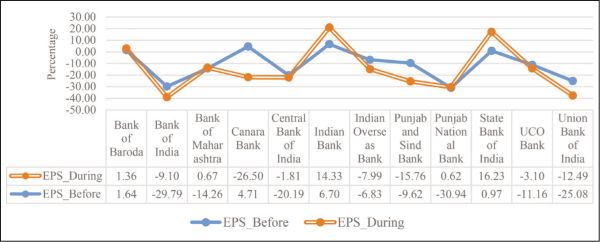
Figure 2 depicts the performance of NPR, which explained NPR of eight select public banks has grown during the COVID-19 pandemic. NPR of four banks have declined during the COVID-19 pandemic, which indicates that the select banks were exercising good cost control. However, the above result showed that most of the select public sector banks were able to quickly adapt the COVID-19 pandemic situation and efficiently convert the invested money into net income.
Figure 2. Net Profit Ratio.
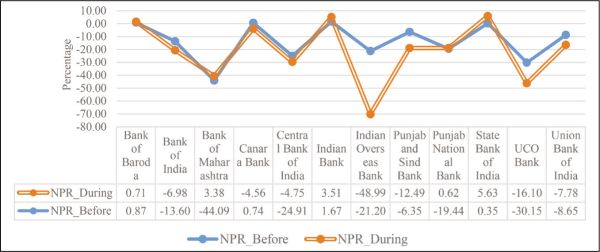
Figure 3 depicts the performance of ROCE, which explained ROCE of seven select banks has grown during the COVID-19 pandemic. ROCE of five banks has declined during the COVID-19 pandemic, which indicates that the select banks were efficient in their operations. However, the above result showed that most of the public sector banks were able to quickly adapt the COVID-19 pandemic situation and good at turning sales into profits.
Figure 3. Return on Capital Employed.
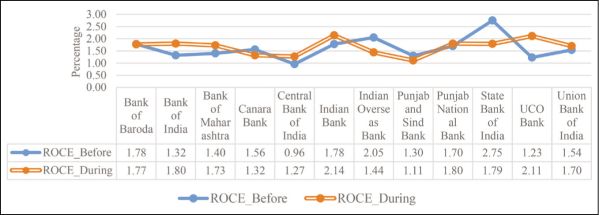
Figure 4 depicts the performance of ROA, which explained ROA of eight select banks have grown during the COVID-19 pandemic. ROA of four select banks have declined during the COVID-19 pandemic. However, the above result showed that most of the select public sector banks were able to quickly adapt the COVID-19 pandemic situation and effectively use the assets in generating income of the respective banks.
Figure 4. Return on Assets.
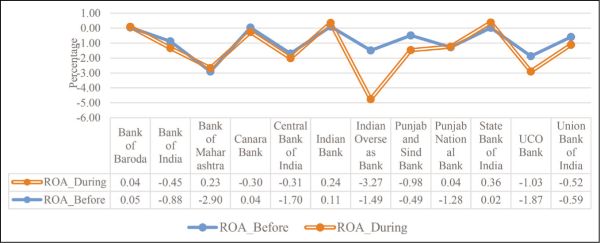
Figure 5 depicts the performance of ROE, which explained ROE of eight select banks has grown during the COVID-19 pandemic. ROE of four banks has declined during the COVID-19 pandemic, which indicates that the select banks were effectively use its equity. However, the above result showed that most of the select public sector banks were able to quickly adapt the COVID-19 pandemic situation and efficiently use their equity capital in generating revenue for the select banks.
Figure 5. Return on Equity.
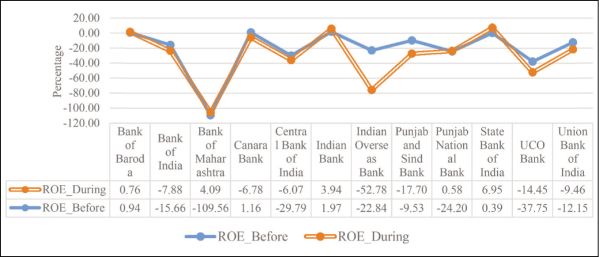
Figure 6 depicts the performance of CR, which explained CR of ten select banks has grown during the COVID-19 pandemic. CR of two select banks has declined during the COVID-19 pandemic, which indicates that the select banks have good financial health. However, the above result showed that most of the select public sector banks quickly adapted the COVID-19 pandemic situation and efficiently managed their short-term solvency position.
Figure 6. Current Ratio.
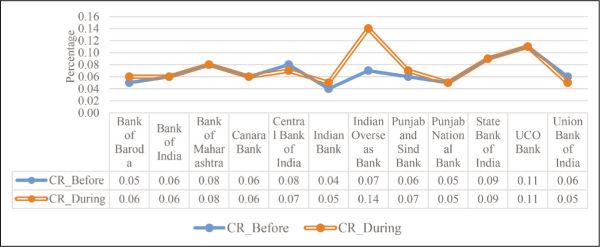
Figure 7 depicts the performance of DER, which explained DER of two select banks have grown during the COVID-19 pandemic. DER of ten select banks have declined during the COVID-19 pandemic, which indicates that the select banks were not significantly funded by debt. However, the above result showed that most of the select public sector banks were not enough funded by debt and not able to quickly adapt the COVID-19 pandemic situation in relation to financial leverage.
Figure 7. Debt to Equity Ratio.

Figure 8 depicts the performance of EVA, which explained EVA of six select banks have improved during the COVID-19 pandemic. EVA of six select banks have declined during the COVID-19 pandemic, which indicates that the chosen banks have created more value for their shareholders than they have destroyed. However, the foregoing result demonstrated that the majority of the chosen public sector banks were able to generate returns sufficient to cover their cost of capital and have been able to increase value for their shareholders throughout the COVID-19 pandemic crisis.
Figure 8. Economic Value Added.
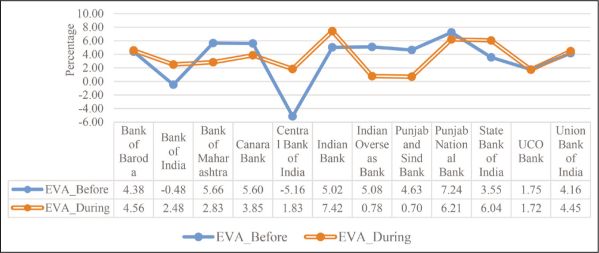
Table 1 shows the findings of the descriptive analysis. From the aspect of profitability ratio, the average value of the EPS before the COVID-19 pandemic and during the COVID-19 pandemic were –11.15 and –3.63, respectively. The increase in average EPS indicated that the COVID-19 pandemic has not harmed the shareholder’s income and public sector banks were utilising their available sources to increase the value of their shares. The average value of the NPR before the COVID-19 pandemic and during the COVID-19 pandemic were –13.73 and –7.32, respectively. The positive growth of the average NPR indicated that the public sector banks generated enough profit during the COVID-19 pandemic. The average value of the ROCE before the COVID-19 pandemic and during the COVID-19 pandemic were 1.61 and 1.67, respectively. The positive value of average ROCE indicated that the public sector banks had enough capacity to generate revenue, which is earned from the operations during the COVID-19 pandemic. The average value of ROA of public sector banks before the COVID-19 pandemic and during the COVID-19 pandemic were –0.92 and –0.5, respectively, which indicated that the COVID-19 pandemic situation has not harmed the public sector bank’s assets in the way of generating income. The average value of ROE of public sector banks were –21.42 and –8.23, respectively, which indicated that public sector banks were using their equity capital effectively during the COVID-19 pandemic.
Regarding liquidity ratios, the average CR values before and during the COVID-19 epidemic were 0.07 and 0.07, respectively. This showed that public sector banks are in the same position with regard to their ability to employ resources to satisfy their short-term obligations.
In terms of solvency ratio, the average value of the DER before and during the COVID-19 epidemic was 15.02 and 12.88, respectively, which indicated that the public sector banks were not significantly funded by debt during the COVID-19 pandemic.
From the aspect of shareholder’s value creation, the average value of the EVA before the COVID-19 pandemic and during the COVID-19 pandemic were 3.45 and 3.57, respectively, which indicated that public sector banks has created the value for their shareholders during the COVID-19 pandemic.
Table 2 shows the Shapiro–Wilk normality test findings, and they show that the selected variables were normally distributed with the required statistical criteria at the 5% level of significance (that is, the corresponding significant value of each variable was greater than 0.05). The aforementioned results show that the selected study variables were normally distributed; hence, the parametric statistical test was performed using the paired samples t-test.
Pair 1: From Table 3, it can be observed that EPS is statistically insignificant at a 5% level of significance (Sig. > 0.05). Therefore, the null hypothesis H01 is accepted. A high significance value of more than 0.05 indicates that there is no significant difference between EPS before and during the COVID-19 pandemic. Based on the result of profitability position, it can be concluded that the COVID-19 pandemic has had a weak impact on EPS.
Pair 2: From Table 3, it can be observed that NPR is statistically insignificant at a 5% level of significance (Sig. > 0.05). Therefore, the null hypothesis H01 is accepted. A high significance value of more than 0.05 indicates that there is no significant difference between NPR before and during the COVID-19 pandemic. Based on the result of profitability position, it can be concluded that the COVID-19 pandemic has had a weak impact on NPR.
Pair 3: From Table 3, it can be observed that ROCE is statistically insignificant at a 5% level of significance (Sig. > 0.05). Therefore, the null hypothesis H01 is accepted. A high significance value of more than 0.05 indicates that there is no significant difference between ROCE before and during the COVID-19 pandemic. Based on the result of profitability position, it can be concluded that the COVID-19 pandemic has had a weak impact on ROCE.
Pair 4: From Table 3, it can be observed that ROAs are statistically insignificant at a 5% level of significance (Sig. > 0.05). Therefore, the null hypothesis H01 is accepted. A high significance value of more than 0.05 indicates that there is no significant difference between ROAs before and during the COVID-19 pandemic. Based on the result of profitability position, it can be concluded that the COVID-19 pandemic has had a weak impact on ROAs.
Pair 5: From Table 3, it can be observed that ROE is statistically insignificant at a 5% level of significance (Sig. > 0.05). Therefore, the null hypothesis H01 is accepted. A high significance value of more than 0.05 indicates that there is no significant difference between ROE before and during the COVID-19 pandemic. Based on the result of profitability position, it can be concluded that the COVID-19 pandemic has had a weak impact on ROE.
Pair 6: From Table 3, it can be observed that CR is statistically significant at a 5% level of significance (Sig. < 0.05). Therefore, the null hypothesis H02 is rejected. A low significance value of less than 0.05 indicates that there is a significant difference between CR before and during the COVID-19 pandemic. Based on the result of liquidity position, it can be concluded that the COVID-19 pandemic has had a strong impact on CR.
Pair 7: From Table 3, it can be observed that DER is statistically significant at a 5% level of significance (Sig. < 0.05). Therefore, the null hypothesis H03 is rejected. A low significance value of less than 0.05 indicates that there is a significant difference between DER before and during the COVID-19 pandemic. Based on the result of solvency position, it can be concluded that the COVID-19 pandemic has had a strong impact on DER.
Pair 8: From Table 3, it can be observed that EVA is statistically significant at a 5% level of significance (Sig. < 0.05). Therefore, the null hypothesis H04 is rejected. A low significance value of less than 0.05 indicates that there is a significant difference between EVA before and during the COVID-19 pandemic. Based on the result of shareholders’ value creation, it can be concluded that the COVID-19 pandemic has had a strong impact on EVA.
Conclusion, Suggestion and Limitations
This research leads to the following conclusions: (a) Profitability ratios showed positive improvement during the COVID-19 pandemic situation, this might have indicated that the public sector banks can generate enough income to cover the bank’s expenses and also indirectly increase the shareholder’s wealth; (b) liquidity ratio of public sector banks are showed positive improvement during the COVID-19 pandemic situation, which indicated that banks seem to be reduced to giving their loan out in order to maintain more liquid cash and assets to prevent unpredictable situation occurred during COVID-19 pandemic; (c) according to the financial leverage of public sector banks, the decline in financial leverage is due to a decrease in debt capacity. Although there are some evidence that some banks’ increased financial leverage is due to previously unutilised loan capacity; (d) from the wealth creation point of view, some of the public sector banks have experienced that decline in EVA and some of them have experienced that increment in EVA. So, the reason might cause by the conflict of interest between the shareholders and some bank’s management level especially during the COVID-19 pandemic situation. In most cases banks would prefer capital funds from investors and be able to create wealth for their shareholders; (e) there are no significant differences in the profitability ratio of public sector banks between before and during the COVID-19 pandemic; (f) there are significant differences in the liquidity ratio, solvency ratio and EVA of public sector banks between before and during the COVID-19 pandemic; (g) all of these findings are consistent with paired sample t-test, which demonstrated that most of the select banks had no positive influence on profitability during the COVID-19 epidemic, while others few has had changed; and (h) the public sector banks have experienced the growth in EPS, NPR, ROCE, ROAs, ROE, CR and EVA during the COVID-19 pandemic, while the public sector banks have experienced a decline in DER during the COVID-19 pandemic.
The results of this study can be used as a source of useful information for investors, and prospective investors can use the data to make financial decisions in the event of a COVID-19 pandemic breakout. The government can utilise the study’s findings to decide how important it is to provide the impacted public sector banks with the proper tax incentives. In order to lessen the negative impact on the financial performance of the banking sectors during pandemic conditions and clear the way for a long-term recovery, policymakers must be prepared to scale up their response as circumstances change. To prevent long-term economic harm to the banking industry and other financial institutions, they must simultaneously make sure that decisions are founded on legislation and that discretion is restrained.
This study’s limitations are as follows: Only hypotheses can be proven by researchers 02, 03 and 04, where these hypotheses proved that CR, DER and EVA have a significant difference between before and during the COVID-19 pandemic. Meanwhile, EPS, NPR, ROCE, ROA and ROE have not changed significantly between before and throughout the COVID-19 pandemic. Hypothesis 01 is not proven, so it is important to re-examine variables with variations of another indicator to measure bank’s profitability. The study did not look at changes in the financial performance of other key financial sectors, therefore the findings are still limited to public sector banks. It is anticipated that more research will be done on the private sector banks, small finance banks, non-banking financial companies, and other related financial sectors with the highest potential for improved financial performance with respect to EVA and financial ratios in order to concentrate investor attention more precisely.
Declaration of Conflicting Interests
The authors declared no potential conflicts of interest with respect to the research, authorship and/or publication of this article.
Funding
The authors received no financial support for the research, authorship and/or publication of this article.
Alarifi, A. A., & Husain, K. S. (2023). The influence of Internet banking services quality on e-customers’ satisfaction of Saudi banks: Comparison study before and during COVID-19. International Journal of Quality & Reliability Management, 40(2), 496–516.
Al-Hroot, Y. A. (2016). The impact of mergers on financial performance of the Jordanian industrial sector. International Journal of Management & Business Studies, 6(1), 2230–9519.
Alsamhi, M. H., Al-Ofairi, F. A., Farhan, N. H., Al-Ahdal, W. M., & Siddiqui, A. (2022). Impact of Covid-19 on firms’ performance: Empirical evidence from India. Cogent Business & Management, 9(1), Article 2044593.
Atayah, O. F., Dhiaf, M. M., Najaf, K., & Frederic, G. F. (2022). Impact of COVID-19 on financial performance of logistics firms: Evidence from G-20 countries. Journal of Global Operations and Strategic Sourcing, 15(2), 172–196.
Benaraba, C. M. D., Bulaon, N. J. B., Escosio, S., Narvaez, A. H. G., Suinan, A. N. A., & Roma, M. N. (2022). A comparative analysis on the career perceptions of tourism management students before and during the COVID-19 pandemic. Journal of Hospitality, Leisure, Sport & Tourism Education, 30, 100361. https://doi.org/10.1016/j.jhlste.2021.100361
Bobade, P., & Alex, A. (2020). Study the effect of covid-19 in Indian banking sector. JournalNX, 179–184. https://www.neliti.com/publications/336056/study-the-effect-of-covid-19-in-indian-banking-sector
Daniya, A. A., Onotu, S., & Abdulrahaman, Y. (2016). Impact of merger and acquisitions on the financial performance of deposit money banks in Nigeria. Arabian Journal of Business and Management Review, 6(4), 1–5.
Daryanto, H. K., & Sasongko, H. (2019). The effect of financial ratio, EVA and exchange rate on stock return in fishery subsector. Asian Journal of Business and Management, 7(1). https://doi.org/10.24203/ajbm.v7i1.5720
Das, R. (2015). Liquidation of cooperative banks in India: Implications of performance indicators for liquidation. ACRN Oxford Journal of Finance and Risk Perspectives, 4(4), 1–22.
Demirgüç-Kunt, A., Lokshin, M., & Torre, I. (2020). The sooner, the better: The early economic impact of non-pharmaceutical interventions during the COVID-19 pandemic (Policy Research Working Paper, 9257). World Bank. https://openknowledge.worldbank.org/server/api/core/bitstreams/1330ec71-45f8-51b8-9b2d-99b71cfff84c/content
Duggal, N. (2015). Post-merger performance of acquiring firms: A case study on Indian pharmaceutical industry. International Journal of Research in Management and Business Studies, 2(3), 24–28.
Foglia, M., Addi, A., & Angelini, E. (2022). The Eurozone banking sector in the time of COVID-19: Measuring volatility connectedness. Global Finance Journal, 51, 100677. https://doi.org/10.1016/j.gfj.2021.100677
Fraser, L. M., Ormiston, A., & Mukherjee, A. K. (2016). Understanding financial statements. Pearson.
Gazi, M. A. I., Nahiduzzaman, M., Harymawan, I. M., Masud, A., & Dhar, B. K. (2022). Impact of COVID-19 on financial performance and profitability of banking sector in special reference to private commercial banks: Empirical evidence from Bangladesh. Sustainability, 14(10), 6260. https://doi.org/10.3390/su14106260
Gurbaxani, A., & Gupte, R. (2021). A study on the impact of COVID-19 on investor behaviour of individuals in a small town in the state of Madhya Pradesh, India. Australasian Accounting, Business and Finance Journal, 15(1), 70–92.
Handayani, R., & Zulyanti, N. R. (2018). Influence of earning per share (EPS), debt to equity ratio, (DER), return on assets (ROA) on share returns in manufacturing companies registered on BEI. Journal of Product Innovation Management (JPIM), 3(1), 615–620.
Harrison, J. S., Hitt, M. A., & Hoskisson, R. E. (1991). Synergies and post-acquisition performance: Differences versus similarities in resource allocations. Journal of Management, 17(1), 173–190.
Hasan, F., Bellenstedt, M. F. R., & Islam, M. R. (2023). Demand and supply disruptions during the Covid-19 crisis on firm productivity. Global Journal of Flexible Systems Management, 24(1), 87–105.
Jayaraman, A. R., Srinivasan, M. R., & Arunachal, R. (2014). Impact of merger and acquisition on the efficiency of Indian banks: A pre-post analysis using data envelopment analysis. International Journal of Financial Services Management, 7(1), 1–18.
Khan, M. A., Khan, M. I., Illiyan, A., & Khojah, M. (2021, September). The economic and psychological impacts of COVID-19 pandemic on Indian migrant workers in the Kingdom of Saudi Arabia. Healthcare, 9(9), 1152.
Kumar, V., & Kumar, S. (2021). Impact of Covid-19 on Indian economy with special reference to banking sector: An Indian perspective. International Journal of Law, Management & Humanities, 4(1), 12.
Mishra, P. K., & Mishra, S. K. (2023). Do banking and financial services sectors show herding behaviour in Indian Stock Market amid COVID-19 pandemic? Insights from quantile regression approach. Millennial Asia, 14(1), 54–84.
Nicola, M. O. (2020). Evidence based management guideline for the COVID-19 pandemic: Review article. International Journal of Surgery, 77, 206–216. https://doi.org/10.1016/j.ijsu.2020.04.001
Normasyhuri, K., Erisna, N., & Setiawan, P. A. (2023). The dynamic of Red Plate Bank’s financial performance before and during the pandemic. Jurnal REKSA: Rekayasa Keuangan, Syariah dan Audit, 10(1), 24–35.
Patel, F. (2015). Effects of accounting information system on organizational profitability. International Journal of Research and Analytical Reviews, 2(1), 168–174.
Patel, R. (2018). Pre & post-merger financial performance: An Indian perspective. Journal of Central Banking Theory and Practice, 7(3), 181–200.
Perwej, A. (2020). The impact of pandemic COVID-19 on the Indian Banking System. International Journal of Recent Scientific Research, 11(10), 39873–39883.
Rakshit, B., & Basistha, D. (2020). Can India stay immune enough to combat COVID-19 pandemic? An economic query. Journal of Public Affairs, 20(4), e2157.
Rhamadana, R. B., & Triyonowati, T. (2016). Financial ratio analysis to assess financial performance at PT HM Sampoerna Tbk. Journal of Management Science and Research (JIRM), 5(7).
Sahoo, P. B. B., & Thakur, V. (2023). Enhancing the performance of Indian micro, small and medium enterprises by implementing supply chain finance: Challenges emerging from COVID-19 pandemic. Benchmarking: An International Journal, 30(6), 2110–2138.
Singh, J., & Bodla, B. S. (2020). Covid-19 pandemic and lockdown impact on India’s banking sector: A systemic literature review. In COVID-19 pandemic: A global challenge (pp. 21–32). Aryan Publication.
Stewart, G. (1991). The quest for value. Harper Collins Publishers.
Stewart, G. (1994). EVA: Fact or fantasy? Journal of Applied Corporate Finance, 7(2), 71–84.
Tikasari, N., & Surjandari, D. A. (2020). The effect of economic value added and financial performance on stock return. Saudi Journal of Business and Management Studies, 5(6), 343–352.
Trivedi, K. (2021). Systemic risk in Indian banking: Measurement and impact of COVID-19. Economics & Applied Informatics, 27(1), 143–151.
Vulanovic, M. (2017). SPACs: Post-merger survival. Managerial Finance, 43(6), 679–699.
Weber, R. H., & Darbellay, A. (2010). Legal issues in mobile banking. Journal of Banking Regulation, 11(2), 129–145.